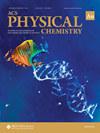GO@β-Ag2MoO4 Composite: One-Step Synthesis, Characterization, and Photocatalytic Performance against RhB Dye
IF 3.7
Q2 CHEMISTRY, PHYSICAL
引用次数: 0
Abstract
The combination of materials to improve properties of interest has become one of the strategies widely used for numerous applications, including new catalysts, over the last few decades. In this study, silver molybdate (β-Ag2MoO4) microcrystals were efficiently obtained by the hydrothermal method, obtaining composites with different amounts of graphene oxide (GO) (1, 2.5, 5, 7.5, and 10%, w/w) using the conventional hydrothermal method. The incorporation of GO on silver molybdate was confirmed by X-ray diffraction (XRD) and Raman spectroscopy, where the vibrational modes and crystallographic planes characteristic of the materials of interest were highlighted. The images collected by scanning electron microscopy (SEM) revealed the occurrence of plate-shaped structures (shells) anchored to the surface of the silver molybdate microcrystals (core). The optical properties showed that the materials presented Egap between 3.34 and 3.39 eV, where the sample with 7.5% of GO (GO@β-AgMo_7.5) was the one that presented energy for the conduction band, largely favorable to the formation of superoxide radicals through the photoexcitation process of electrons. The catalytic tests demonstrated that, among the samples obtained in this study, the sample with 7.5% of GO (GO@β-AgMo_7.5) exhibits superior photocatalytic performance against the dye rhodamine B (RhB) in an aqueous medium. Thus, the kinetics constant for photolysis (absence of catalysts) and for the sample β-AgMo and the sample with 7.5% of GO (GO@β-AgMo_7.5) are 0.38 × 10–3, 12 × 10–3, and 23.72 × 10–3 min–1, respectively. Therefore, it is 62.5 times more efficient in the degradation of the RhB dye, which confirms the promising photocatalytic properties of the obtained composite.

GO@β-Ag2MoO4 复合材料:一步法合成、表征及对 RhB 染料的光催化性能
过去几十年来,通过材料组合来改善相关特性已成为广泛应用的策略之一,包括新型催化剂。在本研究中,通过水热法有效地获得了钼酸银(β-Ag2MoO4)微晶,并利用传统的水热法获得了与不同量的氧化石墨烯(GO)(1、2.5、5、7.5 和 10%,w/w)的复合材料。X 射线衍射(XRD)和拉曼光谱证实了 GO 在钼酸银上的结合,并突出显示了相关材料特有的振动模式和晶体平面。扫描电子显微镜(SEM)收集的图像显示,在钼酸银微晶(核心)表面存在板状结构(外壳)。光学特性表明,这些材料的 Egap 值在 3.34 至 3.39 eV 之间,其中含有 7.5% GO 的样品(GO@β-AgMo_7.5)具有导带能量,这在很大程度上有利于通过电子的光激发过程形成超氧自由基。催化测试表明,在本研究获得的样品中,含有 7.5% GO 的样品(GO@β-AgMo_7.5)对水介质中的染料罗丹明 B(RhB)具有优异的光催化性能。因此,在没有催化剂的情况下,β-AgMo 样品和含有 7.5% GO 的样品 (GO@β-AgMo_7.5) 的光解动力学常数分别为 0.38 × 10-3、12 × 10-3 和 23.72 × 10-3 min-1。因此,它降解 RhB 染料的效率是原来的 62.5 倍,这证实了所获得的复合材料具有良好的光催化性能。
本文章由计算机程序翻译,如有差异,请以英文原文为准。
求助全文
约1分钟内获得全文
求助全文
来源期刊
CiteScore
3.70
自引率
0.00%
发文量
0
期刊介绍:
ACS Physical Chemistry Au is an open access journal which publishes original fundamental and applied research on all aspects of physical chemistry. The journal publishes new and original experimental computational and theoretical research of interest to physical chemists biophysical chemists chemical physicists physicists material scientists and engineers. An essential criterion for acceptance is that the manuscript provides new physical insight or develops new tools and methods of general interest. Some major topical areas include:Molecules Clusters and Aerosols; Biophysics Biomaterials Liquids and Soft Matter; Energy Materials and Catalysis

 求助内容:
求助内容: 应助结果提醒方式:
应助结果提醒方式:


